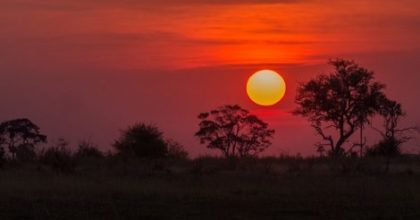
Perhaps you saw the headlines last week about a research paper that claimed to locate the origins of modern humans in a region of what is now Botswana. Many outlets reported the conclusions as stated in the paper. Some coverage, like this BBC article, acknowledges skepticism but not necessarily in great detail. More specifically, the claim is that our collective ancestors first became Homo sapiens in an area centered in modern Botswana from around 200,000 years ago until 130,000 years ago when they began migrating outward. This conclusion is based on analysis of mitochondrial sequence data, linguistics and simulations of the climate in the region over the past few hundred millenia. The biggest challenge to the claim is fossil evidence of anatomically modern humans in eastern Africa but there are other questions as well.
Many Christians have a keen interest in human origins research, for understandable reasons. So it’s important to be careful with what the data do and don’t say. The genomic portion is the type of analysis I am most familiar with. The study involves mitochondrial DNA sequences. Most of our genome is in the nucleus of our cells, but a small part is contained in our mitochondria–intracellular components central to our cellular metabolism. Using what we know about mutation rates in mitochondrial DNA and the observed diversity of current genomes, we can work backwards to the most recent version that could be the common antecedent of all current versions. That’s where the 200,000 years ago estimate comes from, although that is just the most recent timing which need not correspond to the origin of our species. Homo sapiens could have existed prior to that point and been ancestors of the person with most recent antecedent version of our mitochondrial genomes, or their mitochondrial lineages may have simply died out at some point. This is plausible since mitochondrial DNA is (almost) exclusively inherited from our mothers; if at any point a lineage has a males-only generation, that mitochondrial lineage dies out.
Working backwards from present day mitochondrial diversity also contributed to the identification of a place as well as a time. We can make some inferences about what the antecedent mitochondrial genome version looked like in terms of sequence, and then look at where the current variants come from that are most similar to that antecedent version. Of course, genes–especially human genes–are not tied to any one place. There are correlations and affinities to be sure, but also plenty of migration and gene flow, so any claims about your genes indicating that your ancestors came from a certain place should be taken as a statistical best guess and not a statement of genealogical certitude.
That’s not to say mitochondrial genome analysis of this sort tells us nothing. And the researchers do corroborate their inferences with the other data I mentioned. It seems reasonable to think there was a population of humans in the region at that time, but these data do not seem to definitively establish stronger conclusions that those were the first and only anatomically modern humans. Especially since one also needs to consider similar analyses of other portions of our genome that indicate different times and locations. These findings aren’t necessarily in conflict; mitochondrial DNA is inherited differently and so it is possible that different set of lineages have resulted in what we presently observe there than in our nuclear genome. We will likely continue to find more data that help us understand our past in greater detail, but the picture emerging at present involves multiple locations, of which this region of Botswana is likely one but not the only.
Andy has worn many hats in his life. He knows this is a dreadfully clichéd notion, but since it is also literally true he uses it anyway. Among his current metaphorical hats: husband of one wife, father of two teenagers, reader of science fiction and science fact, enthusiast of contemporary symphonic music, and chief science officer. Previous metaphorical hats include: comp bio postdoc, molecular biology grad student, InterVarsity chapter president (that one came with a literal hat), music store clerk, house painter, and mosquito trapper. Among his more unique literal hats: British bobby, captain’s hats (of varying levels of authenticity) of several specific vessels, a deerstalker from 221B Baker St, and a railroad engineer’s cap. His monthly Science in Review is drawn from his weekly Science Corner posts — Wednesdays, 8am (Eastern) on the Emerging Scholars Network Blog. His book Faith across the Multiverse is available from Hendrickson.

Leave a Reply